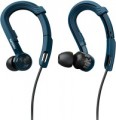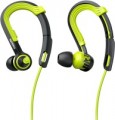The location of the
microphone, which the headphones are equipped with (if available, of course).
— On the cable. A microphone installed on the headphone connection wire (or on the connection cable in non-TWS wireless headphones). Can be combined with
volume control. This option allows you to separate the microphone and headphones, reducing the weight and dimensions of the "ears" themselves; on the other hand, the microphone when worn is often quite far from the face, which can be inconvenient. Therefore, this design is mainly used among earbuds and in-ear
headphones, where the size of the "ears" is critical.
— Built into the body. A microphone located in the housing of one of the headphones. This arrangement is convenient because there are no extra protruding parts outside (as in
headphones without a microphone), while the microphone is close to the face, and in some models it is also able to perceive sound according to the principle of bone conduction. However installation in close proximity to the speaker gives additional interference and may degrade the quality of voice transmission. However, these shortcomings are not critical: interference can be compensated, and the built-in headphone microphones, in fact, do not need perfect sound transmission accuracy. Therefore, this option is quite popular nowadays, and it is fo
...und not only in miniature models, for which the absence of unnecessary details on the outside is important, but also in rather large overhead "ears".
— On the bow. A microphone mounted on a small boom that is attached to one of the headphones. The microphone on the bow is the most popular among overhead headphones: a large cup can be supplemented with a boom without sacrificing convenience, and the microphone itself is located far from the headphones, which has a positive effect on the purity of the sound. The boom often has a swivel or detachable mount, which allows you to remove the microphone from the face until it is needed (by lifting the boom vertically along the headband).
— Retractable on the bow. Headband microphone (see above) with a retractable design: the headband can be pulled out of the cup when needed and can be tucked back inside when not in use. These headphones are more compact and have a neater appearance than models with a headband on a swivel mount: in a hidden position, the microphone takes up almost no space outside. The retractable microphone design is especially popular in gaming models (see “Intended Use”): in single-player games where you do not need to communicate with comrades, the microphone can be folded compactly.
— Removable on the shackle. Headband microphone (see above), which can be completely detached from the headphones if desired. Such a design can be useful, for example, if the “ears” are used both as gaming and as “marching and musical”: in a multiplayer game, the microphone is indispensable, and for listening to music outside the home, it can be removed so as not to carry extra equipment (which besides, you can lose).
— At the receiver. A variant used in wireless headphones with a separate receiver. In terms of design and use, it is similar to the microphone on the cable described above: on the one hand, the headphones themselves can be very light and tiny, on the other hand, the microphone may not be located close enough to the face, and when talking it will have to be brought closer.
— In the mount. In this case, most often means a microphone mounted on a neck mount (see below). This option is found mainly among wireless headphones, which have a signal receiver in the same mount. Such a microphone is located close to the neck, which allows you to achieve good speech intelligibility and at the same time cut off extraneous sounds even without any special additional tricks.
— On the cable and in the case. Headphones equipped with two microphones — one in the case, the other on the cable. The features of these variants are described in detail above. Here we note that their combination is extremely rare, mainly among high-quality "ears" with a combined connection (see "Type of connection"). In such models, when working via a wireless channel, a microphone in the case is used, and when connecting a wire, a microphone on a cable is used, which is less susceptible to interference.
— On cable and removable. Another kind of headphones with two microphones, also quite rare. One microphone in such models is mounted on a cable, the second — on a detachable bow. See above for more on each of these options, and combining them allows you to tailor the headphones to the specific situation. For example, the bow is very convenient for voice communication at home or office computers, but on the street and in transport it is better to remove it and use the microphone on the cable.
— In the case and removable. A rather rare and non-standard option is the combination of a microphone in the case and a microphone on a detachable bow. See above for more details on each of these varieties, and their combination is used quite rarely — in separate premium gaming models with a combined connection. The main point in this case is that it is more convenient to use a removable microphone in one place, with a wired connection, and in the “mobile” wireless mode it is better to remove it and get by with the built-in microphone. However, such features are fundamental mainly for the most demanding users, so this option has not gained distribution.Among the equipment, it is worth highlighting
silicone and
polyurethane tips, relevant for in-ear headphones,
additional fixation nozzles and behind-the-
ear arms for better attachment in the ear,
interchangeable ear pads,
additional cable,
dongle,
aircraft adapter,
case / case and
docking station. There are also other accessories. More details about them:
- Silicone tips. Replaceable silicone tips used in in-ear headphones. Usually, several nozzles of different sizes are supplied in the kit, which allows you to adjust the headphones to a specific user. The practical advantages of silicone are softness, durability, general convenience and at the same time low cost.
- Polyurethane nozzles. Replacement tips for in-ear headphones made of foamed polyurethane. This material is somewhat more expensive than silicone, it requires regular cleaning and has a shorter service life - including due to deformation as it wears. On the other hand, polyurethane is ideal in terms of acoustics; it is these tips that are considered the best choice for lovers of in-ear “ears” with high-quality sound.
- Ear hooks. Removable devic
...es designed to additionally secure each earpiece to the ear. Note that such devices should not be confused with behind-the-ear mounts (see above). The main difference is that the arms are used exclusively in some models of in-ear headphones and earbuds as an additional option. In other words, you can wear such headphones without a bow, while the behind-the-ear mount is usually made non-removable and, in principle, you can’t do without it.
— Nozzles of additional fixation. Auxiliary caps for a tighter fit of the in-ear headphones. They are used to provide better fixation of headphones during sports or provide additional volume to users with a large auricle.
- Replaceable ear pads. Comes with interchangeable ear tips. In general, the ear pads are the part with which the headphones come into contact with the listener's ears. In full-size and on-ear headphones, they are soft pads on the inside of the cups.
— Case (case) / cover. Covers are usually called soft rag bags, they protect the "ears" mainly from pollution and take up a minimum of space. Cases are made of hard materials, they are a little more bulky, but they protect well from shock, pressure and contact with sharp objects. In any case, the complete case or case is optimally suited for the headphones and is more convenient than an impromptu protective casing.
- Charging case. Case - a case made of hard material - simultaneously playing the role of a charger. This feature is very popular on true wireless models (see "Cable Type"). The charging case usually has its own battery and the headphones are already charged from this battery; this design provides additional convenience in several moments at once. Firstly, the case, in fact, also performs the function of a power bank - an autonomous power source; the capacity of such a “power bank” may be different, but it is usually enough for several full charges of the “ears” (for more details, see “Capacity of the case”). Secondly, the ability to charge the headphones directly in the case reduces the risk of losing them. Thirdly, the charging procedure itself is quite convenient - just connect the cable to the case.
- Dock station. Stationary stand with the possibility of placing headphones and contacts for charging them. Also, docking stations are often used to transfer the sound track to headphones - they are connected directly to the sound source via a wire, and the sound is transmitted to the ears wirelessly within a certain radius of action.
— Clip for carrying. A clip designed to fasten the wire to a pocket, collar, lapel of clothing, etc. It provides additional convenience: thanks to the clip, the wire does not hang out, the likelihood of touching it with careless movement or catching on the surrounding object is reduced.
- Additional cable. An additional cable provided in addition to the main one may have different features and specializations. So, complete cables can vary in length, connector type, wire type, additional equipment (microphone, volume control), etc. These details should be specified separately in each case. Here, we note that almost all headphones with this configuration have a detachable cable (it makes sense to supplement a non-detachable wire with an extension cable, and it is considered a separate accessory - see below).
- Extension. A type of additional cable designed solely to increase the overall length of the wire. Due to the extension cord, you can adjust the headphones to the specifics of the situation: for example, “build up” the cable if you need to switch from a laptop to a TV or a stationary audio system.
— Airplane adapter. Dedicated headphone adapter for use with modern airliner entertainment systems. In such systems, a special way of connecting headphones is used - through two 3.5 mm jacks (and we are talking about classic "ears", without a microphone). Models with a traditional single 3.5 mm plug can only be connected to this output through an adapter; such adapters may initially be included in the delivery.
- Windproof microphone. Devices in the form of a foam rubber or "shaggy" lining on the headphone microphone capsule. Cut off unnecessary ambient noise and minimize the effect of direct exposure to air currents on the microphone, which can cause interference in speech transmission.
— Dongle. The dongle is used to simplify the organization of connecting wireless headphones to other devices. In fact, this is a radio transmitter (less often a Bluetooth transmitter) that non-contactly broadcasts sound to headphones from a connected device.
This list is not exhaustive and may include other optional items.
